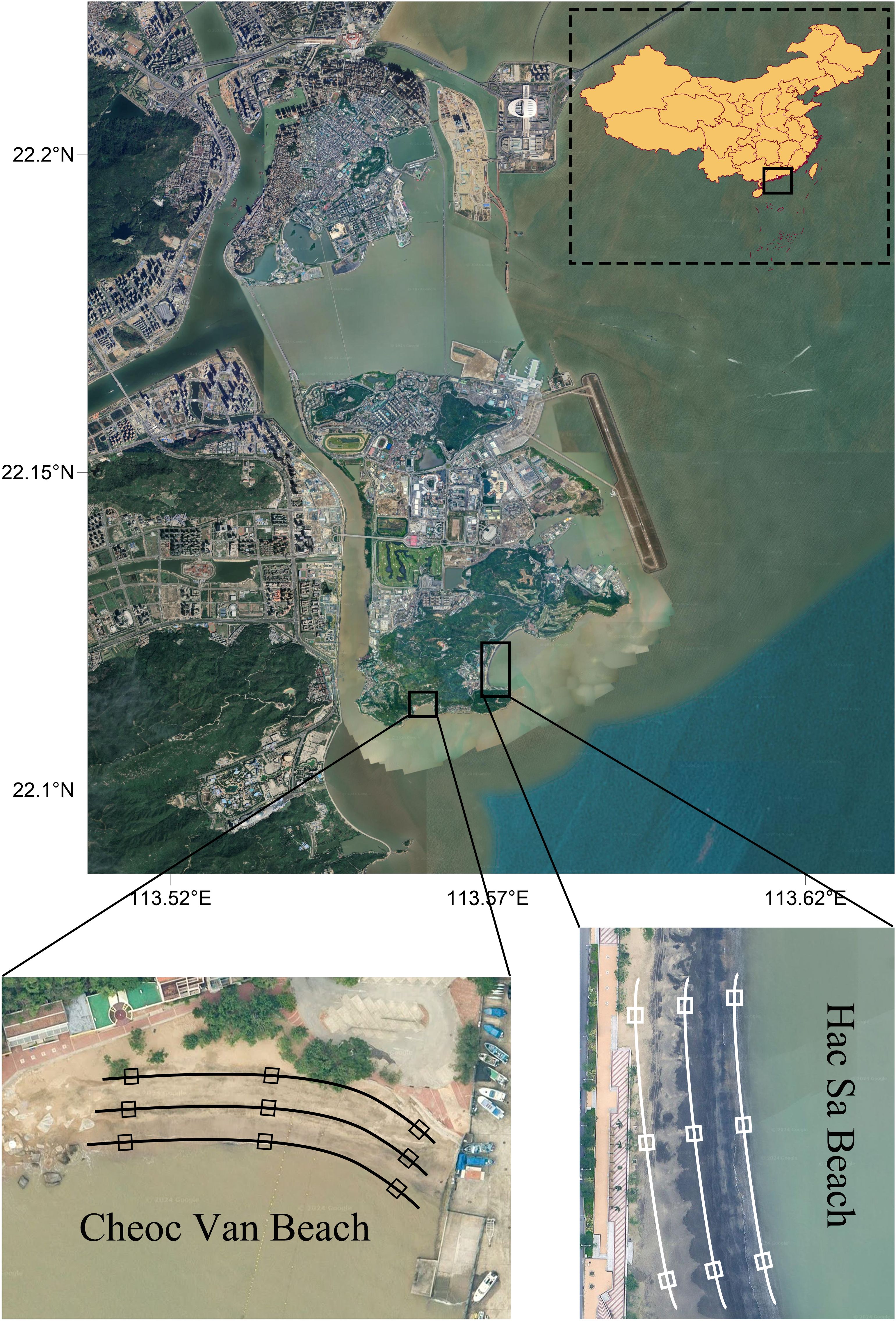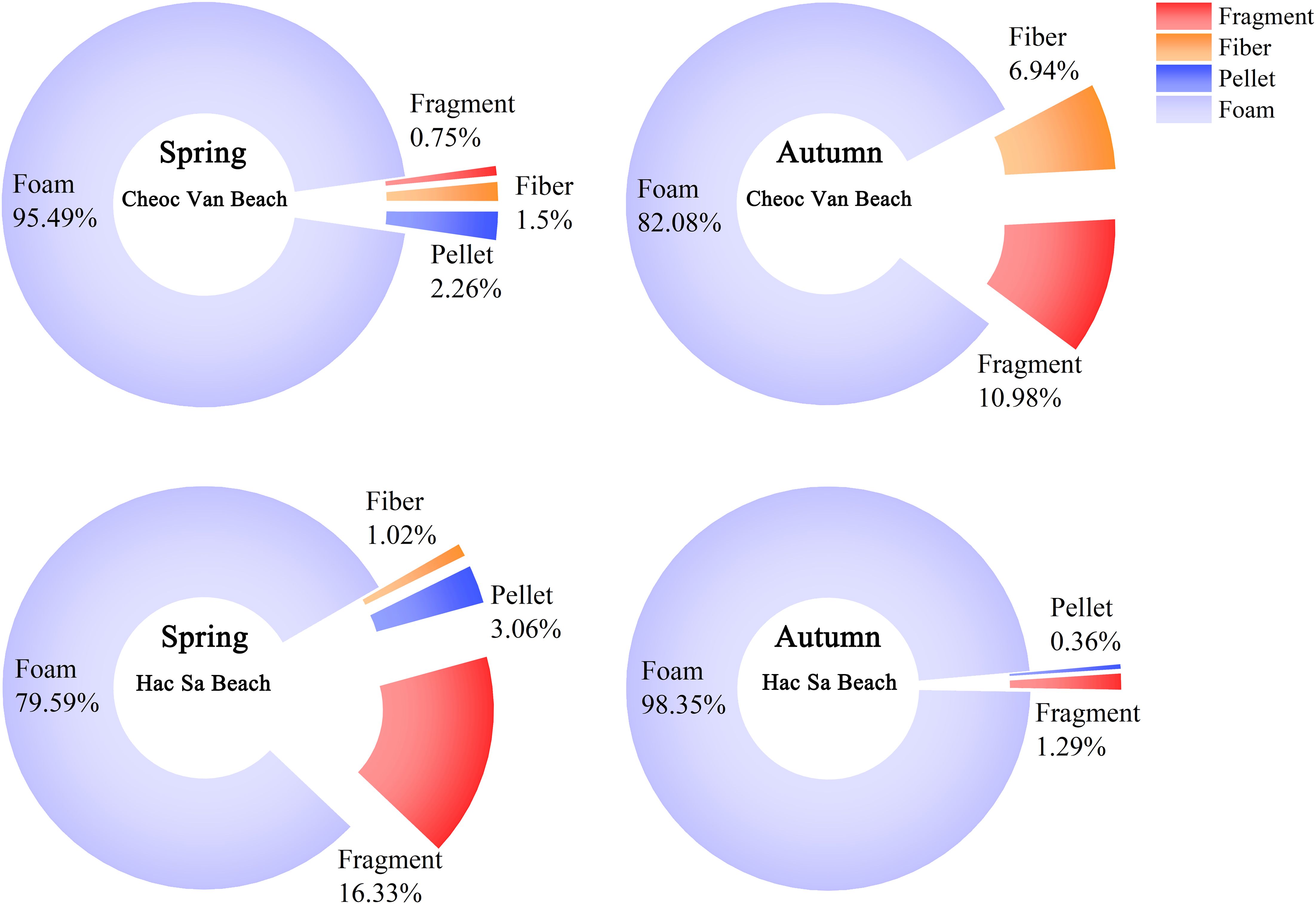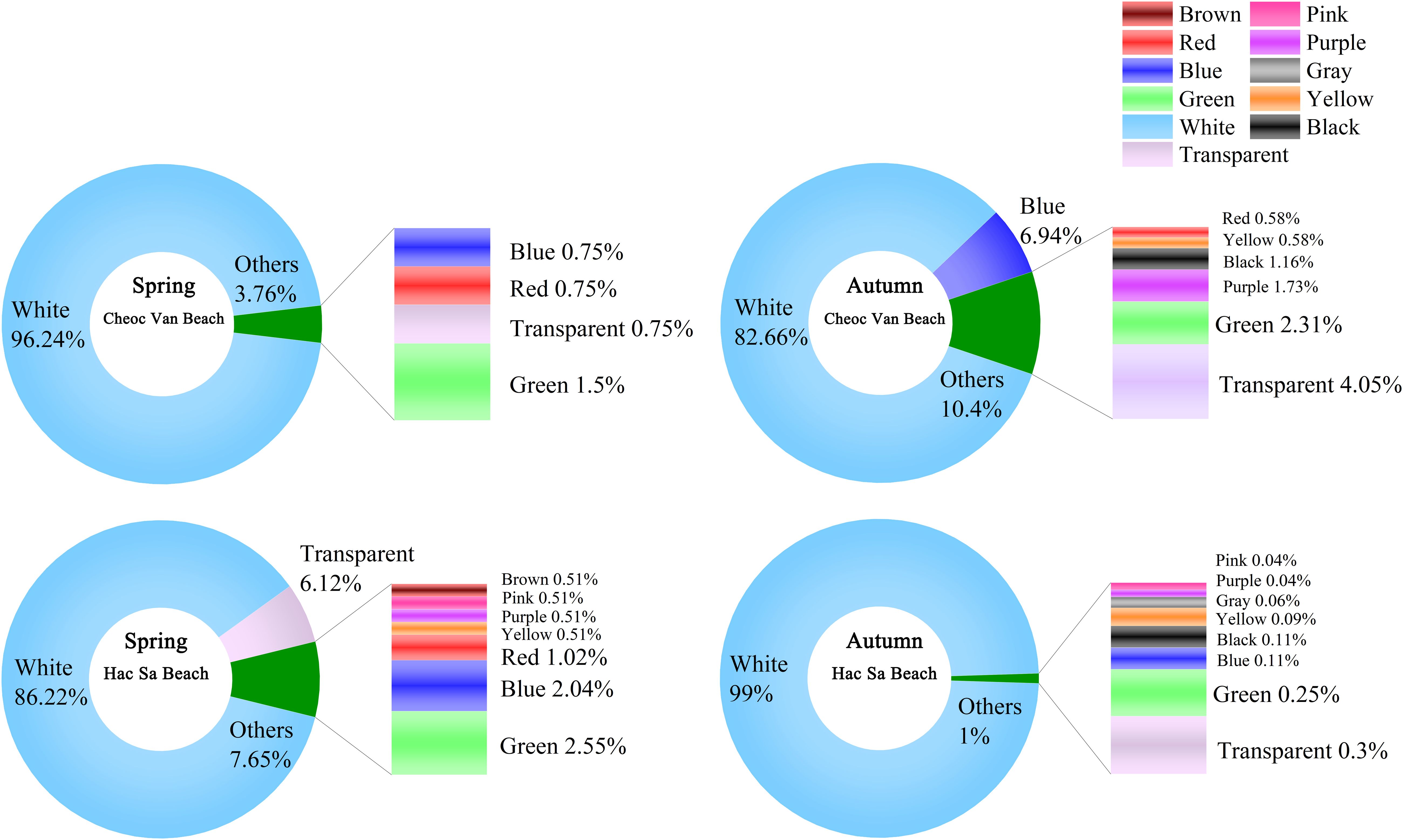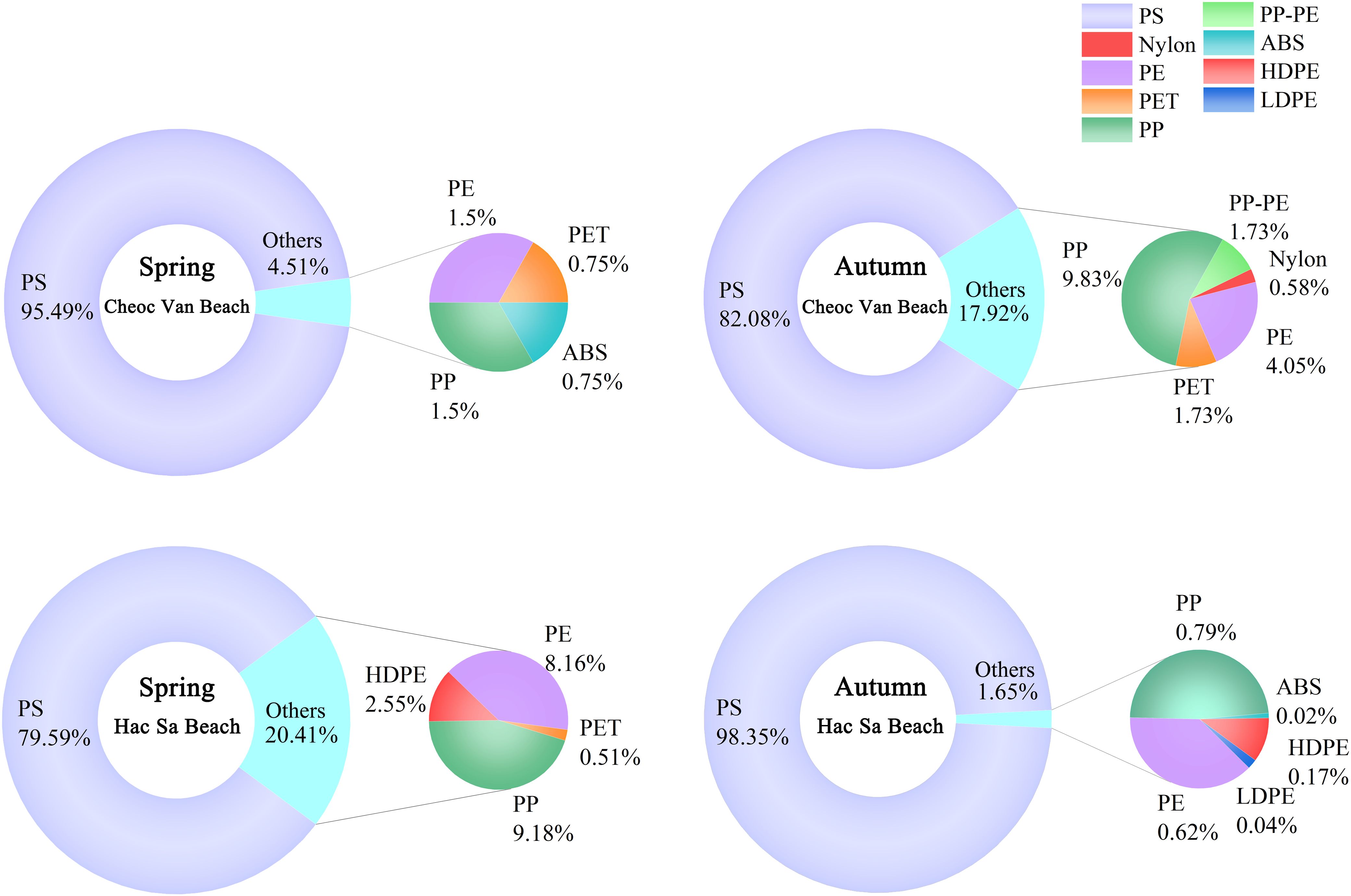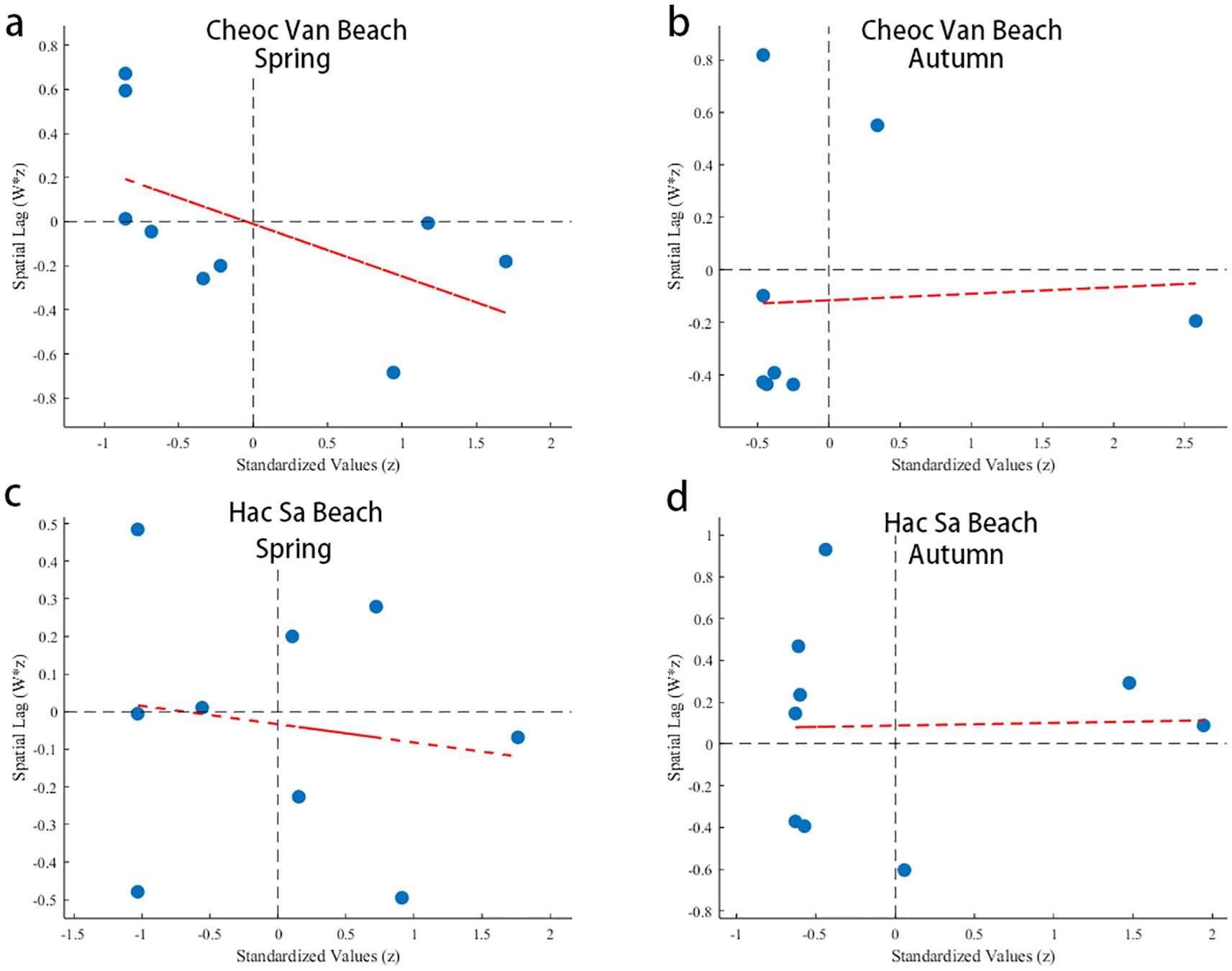- Hainan Institute of East China Normal University, Sanya, Hainan, China
Beaches have been recognized as hotspots of microplastic (MP) pollution, posing an emerging threat to both environment and human health. Understanding the sources and key factors influencing MP distribution on beaches is crucial for developing effective management strategies. Here, MPs in two major tourism beaches with different orientations in Macau were seasonally investigated for the first time. The average abundance of MPs on Macau beaches was 36.56 ± 38.05 n/kg in spring and 628.63 ± 1462.31 n/kg in autumn, with foam accounting for over 85% of the total MPs in both seasons. The spatial autocorrelation of MP distribution across both seasons and beaches was weak, with no significant patterns of spatial clustering or dispersion observed.The abundance of MPs was significantly higher in autumn than in spring, mainly due to the large amount of polystyrene foam brought by the tides from the sea. It was also noticed that the abundance of MPs on windward beaches was significantly higher than that on leeward beaches, highlighting the important role of wind in dominating the MPs on coastal beaches in the studied region. The chemical composition of MPs, analyzed using Fourier-transform infrared (FTIR) spectroscopy, revealed that most MPs originated from nearby areas. The findings will provide scientific insights for policy development aimed at mitigating plastic pollution in densely populated regions.
1 Introduction
Since the first commercial production of plastic in the 1940s, the production and consumption of plastics have rapidly increased (Cole et al., 2011). After stagnating in 2020 due to the Covid-19 pandemic, global plastic production increased to 390.7 million tons in 2021 (Europe, 2022). Due to its lightweight, durability, and cost-effectiveness compared to traditional materials, plastic has been widely used in many manufacturing fields, generating significant social benefits. However, it also represents a double-edged sword, as a significant portion of those plastic products inevitably ends up in the environment, fragementing to smaller particles known as MPs (MPs,<5 mm in diameter).
MPs have been found in various environmental compartments, including water bodies (Yan et al., 2021), sediments (Kanhai et al., 2019), atmosphere (Jahandari, 2023), biological organisms (Zhang et al., 2020) and organisms of human beings. Studies have indicated that MPs can account for more than half of all plastic fragments (Munari et al., 2017), posing threats to both the environment and human health. Beaches are hostspots accumulating plastics and MPs. Plastics make up the largest category of beach litter, reaching 90% of the total waste on some beaches (Laglbauer et al., 2014). The number of plastics increases sharply as their size decreases. Coastal tidal flats are often considered MPareas as MPs sources due to ideal conditions conducive to plastic degradation. Large plastic fragments exposed to sunlight, high temperatures, wave impacts, and contact with bottom sediments such as rocks, gravel, or sand accelerate thermal degradation, photo-oxidation degradation, mechanical fragmentation, and biodegradation of plastic debris (Bissen and Chawchai, 2020; Lenz et al., 2023). Beach samples can well represent the cumulative results of long-term interactions between coastal waters and terrestrial surfaces (Yu et al., 2016). The amount of litter found on beaches is considered an important indicator of marine litter pollution (Dekiff et al., 2014).
Globally, there has been a substantial amount of research on MPs in beach environments. However, the abundance of MPs varies significantly across different regions due to factors such as population, climate, ocean currents, tides, topography, and cleaning activities. Studies have shown that the abundance of MPs recorded in Europe alone ranges widely, from 1 n/kg (Frère et al., 2017) to over 2000 n/kg (Leslie et al., 2017). Understanding the abundance, composition, spatial distribution and key affecting factorsof MPs in beaches at national, regional, and global scales is crucial for supporting effective management of marine plastic debris. Although there has been extensive research on beach MPs in China (Li et al., 2018; Wu et al., 2021), but data in Macau region is still lacking.
Macau beaches face the South China Sea, with diverse pollution sources, affected by both land-based pollutants from the Pearl River Delta region and from sea-based sources from South China Sea. Surrounded by the sea on three sides, its semi-enclosed nature facilitates the recycling of litter, limiting its unrestricted transfer to other marine areas, making it an ideal area for studying pollutants, especially MPs, and their transport. Macau, with its small area and high population density, is one of the world’s most popular tourist destinations, which means it could be a hotspot for MP accumulation.
This study assessed the level of MP pollution at two of Macau’s most popular beaches, Hac Sa Beach on the southeastern coast of Coloane Island and Cheoc Van Beach on the southern coast. By comparing the distribution characteristics of MPs across different seasons, the study aims to analyze the major sources of MPs as well as their potential transport pathways. Furthermore, through spatial autocorrelation analysis, this study investigates the spatial patterns of MP distribution and their underlying mechanisms. The research aims to elucidate how environmental processes and human activities collectively shape MP spatial distribution on coastal beaches, thereby providing a scientific foundation for monitoring and managing coastal MP pollution.
2 Materials and methods
2.1 Sampling area and methods
The coastline of the Macau Special Administrative Region is 76.7 km long, with sandy shores mainly distributed at Hac Sa Beach and Cheoc Van Beach on Coloane Island, accounting for about 3.0% of the total coastline length. Coloane Island is located in the southernmost part of Macau, easily influenced by ocean currents from the South China Sea and the Guangdong coastal current. Hac Sa Beach, on the southeastern side of Coloane Island, is one of the most popular beaches in the Macau region. Cheoc Van Beach, at the southern end of Coloane, is one of most famous bathing beaches which is suitable for various water sports due to its excellent wave and wind conditions.
During October 2020 (autumn) and April 2021 (spring), samples were collected from Hac Sa Beach and Cheoc Van Beach (Figure 1). At each studied beach, three transects (water-edge, high strandline and backshore line) were selected and three samples were collected at 50 m intervals of each transect using a 0.5 m×0.5 m quadrat frame. In total, nine beach sediment samples were collected from each beach during specific month of both seasons., Samples were collected from the top left quarter of the quadrat frame area to a depth of 2.5 cm and sealed in aluminum boxes for further analysis in laboratory.
2.2 MP separation
The extraction method of MPs from beach sediments was the same as that of Zong et al. (2024) (Supplementary Figure S1). First, plastics larger than 5 mm (mesoplastics) in sediments were removed by sieving through a 5 mm pore size (GESAMP, 2019). Samples were then thoroughly dried at 60 °C in the oven. Wet weight before drying and dry weight were recorded using an electronic weighing balance (BSA224S, Sartorius, China). Approximately a 500 g dry weight of sediments from each station was added to the a cleaned floatation apparatus having filtered sodium iodide solution (1.4 g/cm3). The mixture was stirred for 3 min and left covered with aluminum foil for 24 h. After the sediment was completely precipitated, a glass rod was used to drain the flotation solution to the central tube until it overflowed. The process was continued, and a flotation solution was used to rinse the beaker walls. The supernatant flowed into the beaker through a 5 mm hole at the bottom, which was collected, and further digested to remove organic matter using 30% hydrogen peroxid. Lastly, the supernatant digested solution was filtered on glass microfiber filter (Whatman, GF/A No. 1820–047, 1.6-µm pore size, 47 mm diameter) and dried for further identification.
2.3 Microscopic examination and polymer identification
Visual inspection of MPs was carried out under a stereomicroscope (Leica M165 FC, Germany) using the built-in Leica Application Suite X software at different resolutions, mainly including counting and imaging.Proceeding further, the shape (classified as fiber/line, pellet/bead, foam, film, and fragment), color, and size of suspected MPs were observed and categorized. Randomly selected and all suspected MP particles were identified with a micro- Fourier Transformed Infrared Spectroscope (μFT-IR, Thermo Nicolet iN10 MX) under the transmittance mode according to our previous studies (Jabeen et al., 2023). Suspected The spectra were processed by OMNIC™ Picta™ software and compared with the OMNIC polymer spectral library. The polymer type was accepted based on the highest matching percentage (>70%).
2.4 Laboratory pollution control
During the experiments, all experimental utensils and solid chemicals were burnt in a muffle furnace at 450°C, and washed thrice with ultrapure water (filtered by a filter membrane of pore size 0.45 μm). Similarly, all liquid reagents and chemicals were filtered before use. All samples were kept covered with aluminum foil during experiments to avoid unexpected contamination. The whole process of the experiment was completed in a super-cleaned room wearing cotton laboratory clothes and nitrile gloves. In total, two blank glass microfiber filter were always placed uncovered in the surroundings of experimental area as control. After the experiment these filters were observed under the microscope for the presence of any MP particle. It is also an important step to count the possibility external contaminants.
2.5 Data analysis
Data were analysis using IBM SPSS 26. Non-parametric Mann-Whitney U test was applied to examine the significance difference of MP abundance in the same beach in different seasons. Significant and extreme differences were recorded at * =p< 0.05 and ** =p< 0.01, respectively. Matlab R2022b software was used to perform spatial autocorrelation analysis of microplastics on two beaches during the spring and autumn seasons, employing the K-Nearest Neighbors (K-NN) method.
3 Results
3.1 Distribution of MPs in Macao beach
MPs were found abundantly on Macau beaches. The average abundance of MPs in the beach sediments from Hac Sa Beach was higher (43.56 ± 42.21 n/kg in spring and 1218.49 ± 1937.70 n/kg in autumn) than that in Cheoc Van Beach during each season (Figure 2). The MP abundance in autumn at both beaches was significantly higher than in spring; the abundance at Cheoc Van and Hac Sa in autumn was 1.3 and 26.96 times that of spring, respectively. After excluding the large amounts of PS foam, the abundance of MP at Cheoc Van and Hac Sa in autumn was 5.17 and 2.18 times that of spring, respectively.
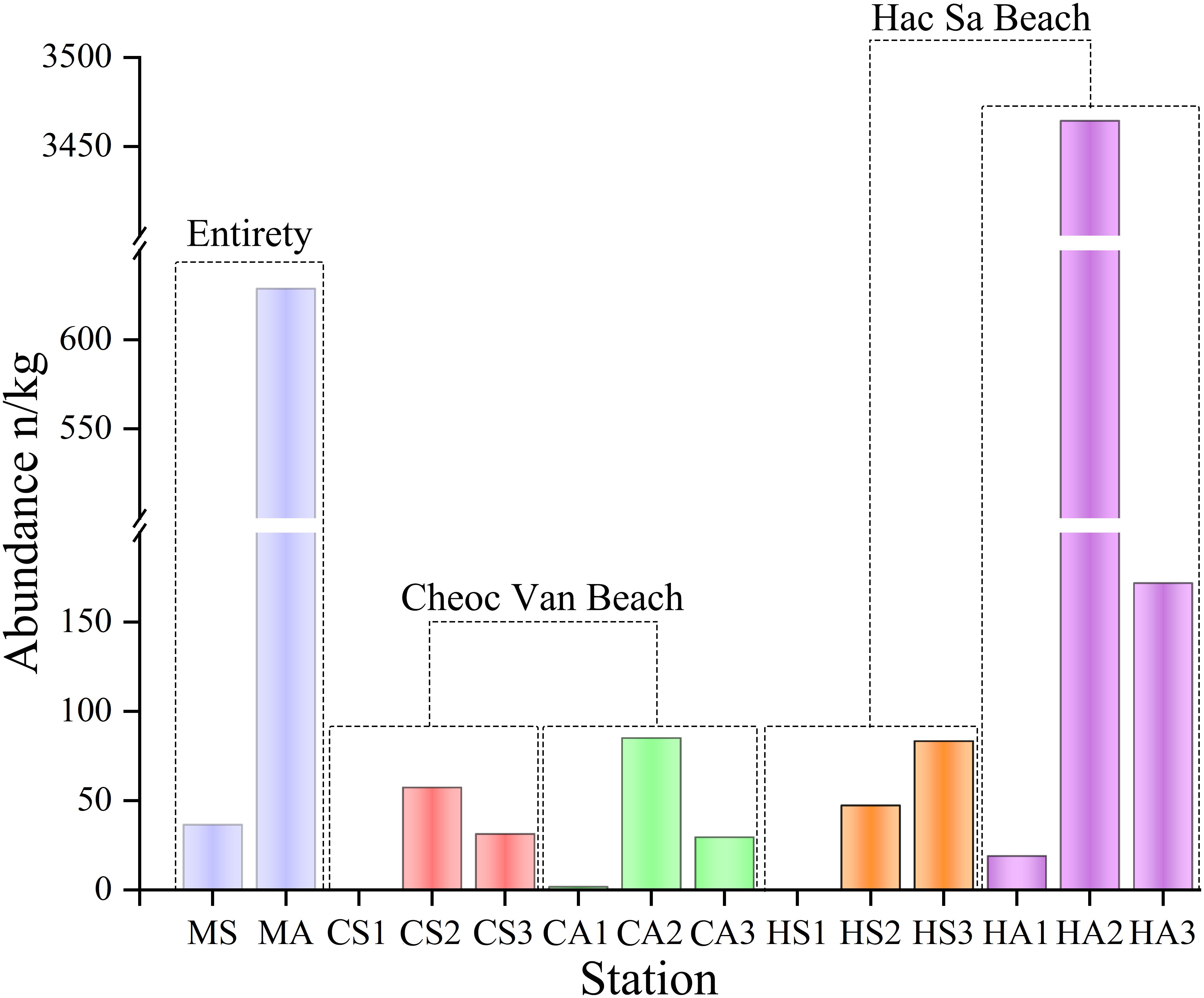
Figure 2. Microplastic abundance in Macau beaches during spring and autumn. MS and MA indicate overall average MP abundance. The three transects at Cheoc Van Beach and Hac Sa Beach, parallel to the shoreline, are named C1, C2, C3 and H1, H2, H3, respectively, from nearshore to inland. Transects for spring and autumn are named CS, CA, HS, and HA, respectively.
Where:
zi and zj are the standardized values (z-scores) of the microplastic abundance at locations i and j. is the mean of the standardized values. Wij represents the spatial weight between points i and j based on the K-nearest neighbor method. The numerator represents the spatial covariance between point i and its neighbors, while the denominator normalizes this by the variance of the data values.
For Cheoc Van Beach in the spring, the Moran’s I value was -0.237, accompanied by a standardized Z-score of -0.177, indicating the absence of significant spatial autocorrelation and suggesting a random distribution of microplastics. In contrast, during the autumn, the Moran’s I value increased to 0.025, with a Z-score of 1.573, reflecting a weak positive spatial autocorrelation and implying a slight clustering of microplastics. These results imply that the spatial distribution of MPs on Cheoc Van Beach during both seasons was weakly structured. For Hac Sa Beach in spring, the Moran’s I value was -0.049, with a Z-score of 0.784, demonstrating an absence of notable spatial autocorrelation. In autumn, the Moran’s I value shifted to 0.013, with a Z-score of 1.415, indicating a positive spatial trend. However, this result also did not meet the threshold for statistical significance, suggesting that the spatial distribution of MPs on Hac Sa Beach in autumn exhibited no discernible clustering or dispersion pattern.
3.2 Morphological categorization of MP
The overall distribution of MPs on Macau beaches is characterized by strip-like bands of debris dominated by foam MPs, interspersed with fragments, fibers, and pellets. A total of 196 MP particles were identified from Hac Sa Beach, with the majority being foam (79.59%), followed by fragments (16.33%), pellets (3.06%), and fibers (1.02%). For the autumn samples, 5285 particles were categorized, predominantly as foam (98.35%), with smaller proportions of fragments (1.29%) and pellets (0.36%). The morphological distribution of MPs during spring showed a notable pattern at Cheoc Van Beach, where foam accounted for the highest proportion (95.49%) among the 133 particles identified. In autumn, 173 MP particles were recorded at the same site, with foam making up 82.08%, followed by fragments (10.98%), and fibers being the least abundant category (Figure 3).
At Cheoc Van Beach in spring, approximately 96.24% of MPs were white, with other colors including blue, green, red, and transparent. Approximately, 82.66% of MPs were white, followed by blue (6.94%) and transparent (4.05%), with other colors black, green, purple, yellow, and red were observed during autumn. At Hac Sa Beach in spring, about 86.22% of MPs were white, followed by transparent (6.12%), with other seven colors. Similarly, white was also a dominat color during autumn (Figure 4).
Five types of polymer were identified at Cheoc Van Beach in spring: polystyrene (PS), polyethylene (PE), polypropylene (PP), polyethylene terephthalate (PET), and acrylonitrile-butadiene-styrene copolymer (ABS). PS was the most common, accounting for 95.49%. Six types of polymer were identified from autum-based samples including PS, PP, PE, nylon, PET, and PP-PE copolymer. PS was the most common, accounting for 82.08%, followed by PP (9.83%) and PE (4.05%). At Hac Sa Beach during spring, five types of polymer were found where PS was the most common, accounting for 79.59%, followed by PP (9.18%) and PE (8.16%) while PS accounted for 98.35% among six polymers in the sediments during autumn (Figure 5).
Regarding size distribution, due to the presence of large, inconsistent-sized PS foam, the size of PS foam was not included for a more intuitive comparison (Figure 6). As a result of microscopic observations, MPs were divided into five size categories: less than 1000 μm, 1000 - 2000 μm, 2000 - 3000 μm, 3000 - 4000 μm, and 4000 - 5000 μm. Overall, the size distribution patterns of MPs were inconsistent across different seasons and beaches. The average size of MPs at Cheoc Van Beach in the spring was 2645.48 ± 1797.68 μm, with a relatively even size distribution. MPs were mainly distributed in the range of less than 1000 μm, with an average size of 1659.16 ± 1316.78 μm during autumn. At Hac Sa Beach, the average size of MPs was 2825.78 ± 1177.21 μm (spring) and 3543.75 ± 1037.86 μm (autumn) as well as size range concentrated greater 1000 μm and 2000 μm during spring and autumn, respectively.
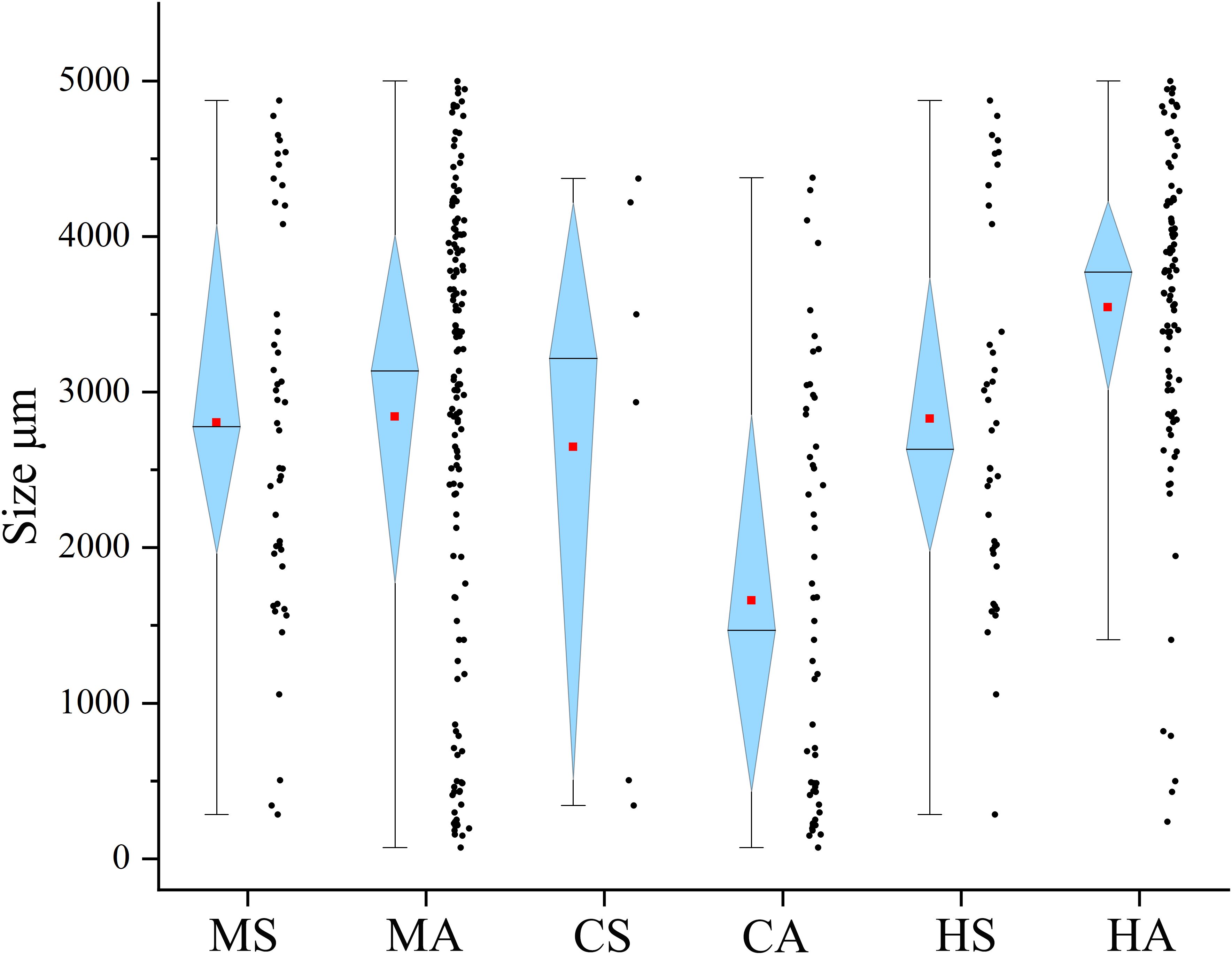
Figure 6. Size distribution of MPs in Macau beach sediments during spring and autumn The codes MS and MA refer to overall average MP abundance. Transects for spring and autumn are named CS, CA, HS, and HA, respectively.
4 Discussion
4.1 MP pollution level on Macau beaches
Overall, the average abundance on Macau beaches in spring was 36.56 ± 38.05 n/kg. Globally, MP pollution on Macau beaches in spring was generally at a low level, significantly lower than heavily impacted regions like Mediterranean tourist beaches (1,512 n/kg; Lots et al., 2017) and below the Bohai Sea coastal average (163.3 n/kg; Yu et al., 2016). Studies have shown that areas without river inflow have lower MP abundance (Piñon-Colin et al., 2018). Although the abundance was found higher in this study compared with the German island of Norderney, it seems because the study considered microfibers as background contamination and excluded plastic fibers, as a result they only counted/reported MP particles in the range of 100-1000 μm (Dekiff et al., 2014). We found our results regarding MP abundance comparable to some Mexican beaches, where, in the spring, just 2 of 35 beaches had less MP than Macau (Alvarez-Zeferino et al., 2020).
In autumn, the high abundance at Hac Sa Beach influenced the overall average MP abundance on Macau beaches, reaching 628.63 ± 1462.31 n/kg. This is because the average seemed strongly affected by the large amounts of MPs found at one or more study sites, similar to a study on beaches of the Baltic Sea in Germany (Schröder et al., 2021). In spring, Hac Sa Beach had low MP pollution levels, but during the autumn, it reached globally high levels, comparable to some severely polluted beaches in Italy (1512 n/kg) and Turkey (1154.4 n/kg) (Lots et al., 2017). However, we also found that our study area less polluted than some extremely polluted areas, such as Daebu Island in Korea, where large accumulations of foam plastics resulted in a MP abundance of 46334 ± 71291 n/m² (Kim et al., 2015).
4.2 Seasonal variations in MPs on Macau beaches
The distribution of MPs on two Macau beaches during different seasons showed that the overall abundance of MPs was an order of magnitude higher in autumn than in spring. The seasonal variations in beach MPs seemingly influenced by various factors, which may depend on beach location, tide type, estuary type, climate type, and extreme weather.
Researchers have found different seasonal distribution patterns of MPs in various regions. Studies on seasonal variations in MPs mainly focus on winter and summer, the two seasons with significant differences in monsoon and rainfall. In this study, spring and autumn were selected largely because during these seasons, Macau has a great climatic similarities with monsoon and rainfall, allowing for a clearer demonstration of the factors influencing seasonal variations in MPs in this region.
Tasnim et al. (2023) reported that the abundance and polymer types of MPs were significantly higher in beach sediments during winter (57%) than in summer (43%) in Bangladesh. About 80% of the annual rainfall in this area occurs from June to October, which may wash away surface sediments and transport MPs and other debris deposited in coastal shallow waters, while the opposite occurs in winter. Another study indicated that in some tideless beaches, the central and backshore areas of the beaches remain dry in winter, where low-density plastics and fibers are trapped/accumulated by wind and vegetation (Vidyasakar et al., 2020). In contrast, a study in Hong Kong found that beaches near the Pearl River estuary (western Hong Kong) had significantly higher MP abundance in the rainy season than in the dry season, but no seasonal variation was observed in the eastern part (Cheung et al., 2016). This might be because increased runoff during the rainy season transports large amounts of MPs to this area and retains them there.
In Macau, the spring season (March-May) is a transition period from winter to summer monsoon, mainly influenced by southeast and northeast winds; and the autumn season (September-November) is a transition period from summer to winter monsoon, with prevailing northeast winds. Consistent with our findings, multiple studies have reported higher abundances of MPs on windward beaches (Andrea et al., 2024). A study found that windward beaches had higher MP abundance than leeward beaches, although the difference was not significant (Bosker et al., 2018). However, this conclusion is not entirely consistent with other studies, which found that windward beaches had more plastic debris than leeward beaches (Monteiro et al., 2018). Another study also reported higher MP abundance on windward beaches in the southern Caribbean Curaçao (Debrot et al., 1999). Similarly, researchers found significantly higher meso- and macroplastic content on windward beaches on the beaches of Aruba (de Scisciolo et al., 2016). In our study, both beaches were affected by the northeast monsoon in autumn. Therefore, Hac Sa Beach (windward) has significantly higher MP abundance than Cheoc Van Beach (leeward). This might also be because debris already floating at sea, such as that released by ships, can typically reach the coastline Macau’s coastline to the prevailing winds.
Our analysis revealed statistically significant differences in microplastic abundance between spring and autumn within the same beach orientation, suggesting seasonal variations in hydrodynamic conditions and anthropogenic activities exert stronger influence than orientation itself. Furthermore, pronounced intra-beach heterogeneity was observed across sampling stations, with microplastic concentrations several orders of magnitude higher in the high-water areas of Hac Sa beaches than in the low-water areas. This pattern demonstrates that beach orientation is not the sole determinant, but rather interacts with hierarchical controls. Considering only the monsoon, southeast winds would blow low-density plastics toward the backshore of both beaches, while northeast winds would transport MPs away from Cheoc Van Beach and continue to accumulate on the backshore of Hac Sa Beach. The prevailing winds during both seasons could help in the accumulation of MPs at Hac Sa Beach, explaining its high MP abundance. However, this does not apply to Cheoc Van Beach, as southeast winds are more conducive to MP accumulation at Cheoc Van, while northeast winds would transport MPs away, indicating that the spring MP abundance should be significantly higher than in autumn, but the results seemed opposite.
Extreme weather might change the state of MP deposition in sediments, which has been demonstrated in several studies (Coco Ka Hei Cheung, 2023; Kunz et al., 2023). MPs in underwater sediments could be resuspended due to benthic disturbances caused by seawater, temporarily reducing their presence in sediments. However, the abundance of MPs on beaches could increase sharply, as large amounts of plastic and MP from the sea and other areas are deposited and accumulate on beaches after typhoons. The highest MP abundance on one of the 35 beaches in Mexico was also collected after extreme weather (Alvarez-Zeferino et al., 2020). Summer is the peak typhoon season, during which large quantities of MPs may accumulate in nearshore areas and are transported to the beaches by tidal action or the southwest monsoon. These MPs subsequently remain on the beaches, gradually accumulating until autumn.
4.3 Factors affecting MPs on Macau beaches
The weak spatial autocorrelation observed in this study suggests that MP distribution on the beaches is largely influenced by stochastic processes, such as tidal dynamics, wave action, and wind patterns, rather than intrinsic clustering (Petrovic et al., 2022). The seasonal variation, albeit minor, may reflect changes in MP sources or hydrodynamic conditions between spring and autumn. However, the low Moran’s I values also highlight potential limitations in sampling resolution and scale, suggesting the need for more granular spatial and temporal data (Figure 7).
Furthermore, the physical properties of MPs, such as size, density, shape, and colour, may also play a significant role in determining their spatial distribution on beaches. These properties influence how MPs interact with environmental forces, such as wind and water currents, and their potential to become embedded in the sand or transported across different areas.
Early studies have shown that fragments and fibers account for a higher proportion compared to other shapes of MPs in beach sediments (Yu et al., 2016; Lots et al., 2017). However, in this study, one shape that remained dominant absolutely is was foam, which mainly originates from aquaculture, packaging, and disposable lunch boxes. These MPs are primarily distributed in the mid-to-high tide zones of the beaches, forming strip-like distributions. Without considering foam, the shape distribution of MPs on both beaches also changed with the seasons, shifting from three shapes in spring to two in autumn. However, since the total number of MPs identified at Cheoc Van Beach in spring was small (n=6), this change appears to be incidental.
Meanwhile, in our study, regardless of foam, we observed significant differences in MP abundance between the two seasons on the same beach, but the proportion of microfibers did not change significantly. The proportion of microfibers on Cheoc Van Beach in spring and autumn was 33.3% and 38.7%, respectively, while on Hac Sa Beach it was 5% in spring and not detected in autumn. Similar to our study, surveys along the Baltic Sea coast found no significant temporal and spatial changes in the presence of fibers in beach sediments across four seasons (Stolte et al., 2015).
Some studies conducted on the northern beaches of Taiwan, the Hengchun Peninsula in Taiwan, and Aveiro in Portugal have also reported that white MPs are the most prominent and abundant types in the marine environment (Kunz et al., 2016; Bancin et al., 2019; Chen and Chen, 2020; Prata et al., 2020). White MPs were found at all stations on four beaches in Vietnam (Hien et al., 2020). Color can indicate the synthetic source of MP waste and its role as a pollutant. A study on the island of Lanzarote, Spain, found that white and translucent particles were mainly composed of PP and PE, respectively (Edo et al., 2019), which were the most abundant types of polymers in our study.
The ingestion of MPs by marine organisms poses a serious ecological risk. Studies have shown that various commercial fish and shellfish, such as oysters, often mistake white MPs for zooplankton. This misconsumption can lead to gastrointestinal blockages, ultimately threatening biodiversity and the overall health of marine ecosystems. White foam MPs, in particular, dominate the high tide line due to their lightweight and high buoyancy, which facilitate their transport by coastal winds and their entrapment in upper beach sediments (Browne et al., 2010). Consequently, the high proportion of white foam particles observed in this study raises concerns about their potential impact on the health of marine animals along the coast of Macau. These findings align with a comprehensive survey conducted on Hong Kong’s beaches, which reported that 92% of the MPs identified were foam (Fok and Cheung, 2015). Similarly, extensive surveys of India’s Silver Beach revealed that white MPs were the most abundant type, with their origin likely linked to the severe weathering and discoloration of disposable PET bottles (Vidyasakar et al., 2020). Further supporting evidence comes from recent research on beach sediments in Peru, which found that white MPs - predominantly foam - accounted for 92.32% of the total MP composition (De-La-Torre et al., 2020). These consistent findings across geographically diverse regions highlight the widespread prevalence of white MPs, emphasizing the need for targeted management strategies to mitigate their environmental impact.
A study of South Korean beaches also reported that PS dominated among all types of plastics (Kim et al., 2015). Polymer density appears to be an important factor affecting the circulation of MPs. Low-density plastic fragments may be recycled between beach sediments and seawater to a greater extent than high-density fragments (Graca et al., 2017). Therefore, the dominance of low-density MPs such as PS, PP, and PE on beaches in this study is understandable and similar phenomena have been found in many beach MP surveys (Aslam et al., 2020). LDPE is widely used to manufacture containers, glue bottles, toiletry bottles, and the most common plastic bags. Reports of LDPE in water and sediment samples indicate its widespread distribution in the marine environment (Barnes et al., 2009). Research suggests that a major source of HDPE found to be linked with rope (Aslam et al., 2020), and in this study, HDPE found on Macau beaches was mainly blue, white fragments, and white particles, originating from a wide range of sources including raw materials (primary MPs) and processed products (containers, pipes) broken into secondary MPs.
4.4 Potential sources of MPs in Macau
The fragmentation of MPs on beaches, compared to those in the ocean, depends largely on environmental conditions. UV radiation and higher temperatures in summer can lead to the degradation of plastics on beaches, breaking them into smaller fragments, thus increasing the number of MPs compared to winter, explaining the seasonal variation in MP abundance in the ocean and beaches. The increase in MP abundance on beaches can also be influenced by currents, monsoons, and flood events (Veerasingam et al., 2016). Research suggests that large plastics do not correlate with MPs collected nearby (Lenz et al., 2023), but some MPs on Macau beaches may be produced by the breakdown of on-site plastic fragments, as plastics like basins, mineral water bottles, plastic bags, bottle caps, and a range of other plastic products consistent in color with MPs were found on site. A study on the west coast beaches of the Baltic Sea also confirmed the existence of this phenomenon (Schröder et al., 2021). The composition of MPs at Cheoc Van Beach during both seasons was similar, mainly PS foam. A small amount of ABS was found in spring, mainly used in the automotive, electronics, and construction industries. Buildings, parked cars, and discarded small boats near the beach are possible sources. In autumn, a small amount of nylon material was found, possibly originating from the ropes of small boats docked nearby. At Hac Sa Beach, similar polymer compositions of MPs were found in spring and autumn as at Cheoc Van Beach.
The exposure time of MPs on beaches is also affected by tides. The Gulf of Thailand usually has one high and one low tide per day, causing plastics to be exposed longer on beaches, leading to the degradation of plastics into a large number of secondary MPs (Bissen and Chawchai, 2020). The abundance of MPs in beach samples collected from the high tide line is significantly higher than that from the low tide line possibly due to the longer exposure time (Karthik et al., 2018). In contrast, the sea area near Macau has an irregular semi-diurnal tide, with two high and two low tides per day, which may cause the low tide and mid-tide zones to have more frequent contact with seawater, potentially bringing or taking away more MPs. Studies of the northwestern Mediterranean coast have shown significant differences in abundance between different tidal zones, with the highest abundance found in the high tide zone (Constant et al., 2019). In this study, only the black sand beach in spring exhibited this phenomenon, with the mid-tide zone being the area with the highest MP abundance in other periods, possibly because the main source of MPs is the tide bringing MPs from the ocean rather than being primarily land-based. MPs similar in polymer composition to those found on mainland beaches were also collected from uninhabited island beaches, indicating that currents and tides can transport MPs from the ocean to open coasts and redistribute them (Horn et al., 2019). Another study also showed that MPs found on beaches with little tourism and fishing activities might be transported by currents (Piñon-Colin et al., 2018).
As waves approach the shore, the dissipation of wave energy can cause the deposition of MPs. The lower the wave energy, the higher the deposition rate, and the finer the sediment on the coast, which is more conducive to the deposition of higher buoyancy MPs (Lo et al., 2020). This point has also been confirmed in studies on the western coast of the Baltic Sea, where the beach with the smallest sediment grain size (less than 0.2 mm) showed the highest abundance of MPs (Schröder et al., 2021). At Hac Sa Beach, the sediment grain size is much smaller than that at Cheoc Van Beach, which may be one of the reasons why Hac Sa Beach has a higher density of MPs. Cheoc Van Beach is geographically deep inland, surrounded by land on three sides, with only the southern part facing the sea. Sampling points were set from the eastern to the western part of the beach, with the eastern part sheltered by the bay and the western sampling stations facing the sea. Both in spring and autumn, MPs showed a decreasing trend in abundance from east to west (Figure 8). This indicates that the terrain may be an important factor affecting the distribution pattern of MPs on the beach.
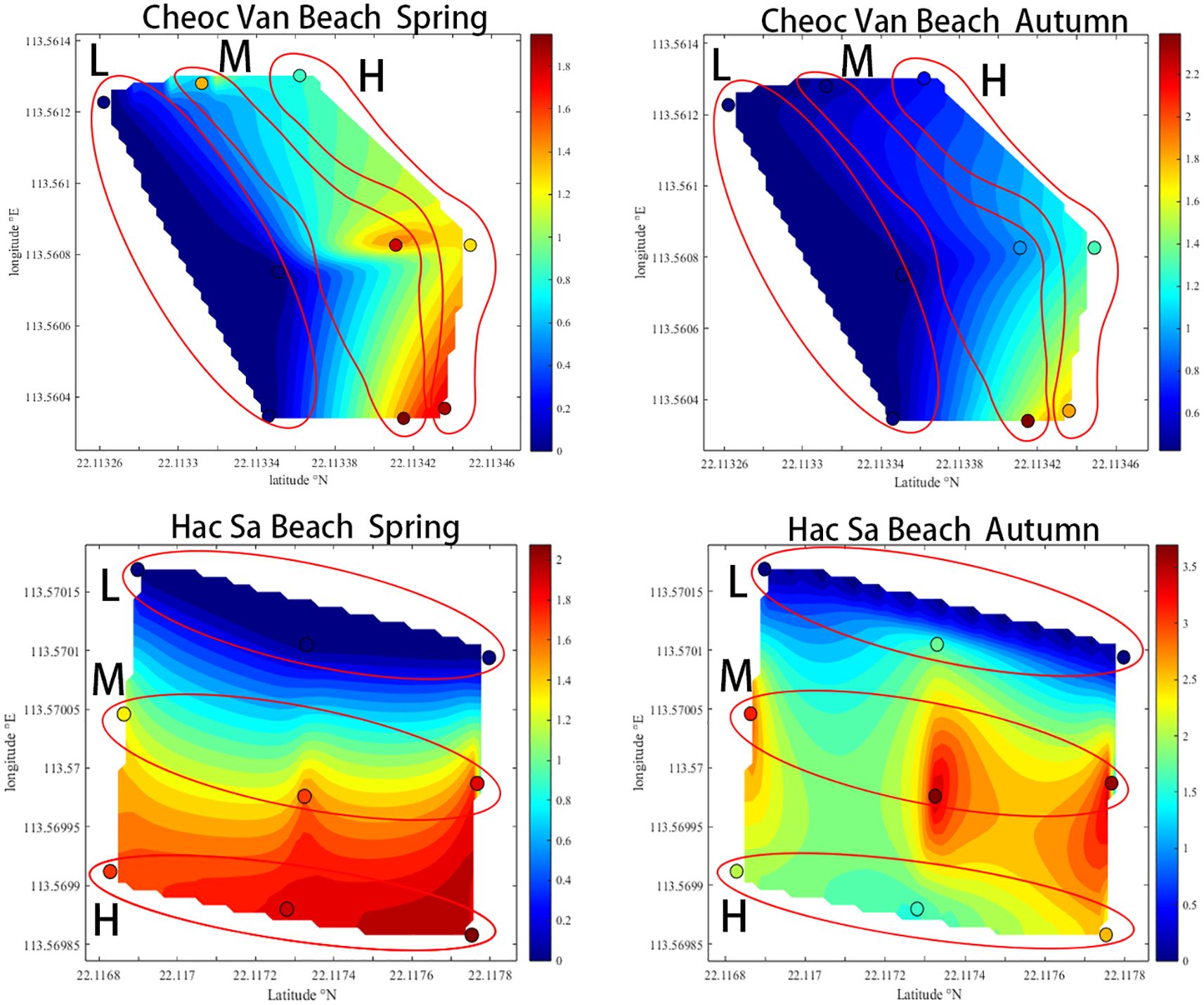
Figure 8. Spatial distribution trend of microplastics on Cheoc Van Beach and Hac Sa Beach across spring and autumn.
A study on MPs in beach sediment cores found that the concentration of MPs in sediments increased over time (Claessens et al., 2011). However, several studies did not observe an increasing trend in MPs in sediment cores over time. Beach sediments are subject to bioturbation, such as by earthworms and polychaetes that can live up to 70 centimeters below the surface. Additionally, tourism cause significant disturbances, such as children building sandcastles and beach cleaning. Consequently, the upper sediment layers may become partially or entirely homogenized, potentially altering or obscuring the true temporal trends (Claessens et al., 2011). At the same time, the abundance of MPs in surface sediments may lead to an underestimation of the actual local concentrations.
Wastewater treatment plants may be point sources for MP emissions. Research suggests that beaches located in areas with numerous wastewater treatment plants have higher MP abundance (Piñon-Colin et al., 2018). Currently, Macau has a total of five wastewater treatment plants or stations, and all of Macau’s wastewater is treated, with the sludge also being incinerated. The treated wastewater from these plants moves southwest along the eastern waters of Macau during low tide and enters Cheoc Van and Hac Sa beaches during high tide. However, the contribution of wastewater treatment plants to beach litter is still unknown.
The beach environment hosts a large number of benthic organisms that feed on sediment and debris, zooplankton, and some filter-feeding organisms. These organisms may mistake or ingest zooplankton containing MPs, leading to the gradual accumulation of MPs up the food chain.
5 Conclusion
This study investigated MP pollution in sediment on two beaches with different orientations in southern Macau, with a focus on seasonal variations. In spring and autumn, the average MP abundance was 36.56 ± 38.05 n/kg and 628.63 ± 1462.31 n/kg, respectively, with significantly higher levels observed on windward beaches compared to leeward ones. Foam-type MPs constituted more than 85% of the total in both seasons, and the elevated concentrations in autumn were primarily attributed to the substantial accumulation of PS foam transported by tidal activity to Hac Sa Beach. The spatial autocorrelation of MP distribution across both seasons and beaches was weak, with no significant patterns of spatial clustering or dispersion observed. By examining the temporal and spatial distribution of MPs in conjunction with factors such as tidal patterns, monsoons, beach orientation, and topography, potential sources were identified. This comprehensive assessment of influencing factors in coastal environments provides valuable insights for developing enhanced strategies for the management and mitigation of MP pollution.
Data availability statement
The original contributions presented in the study are included in the article/Supplementary Material. Further inquiries can be directed to the corresponding author.
Author contributions
CZ: Investigation, Writing – original draft, Conceptualization, Visualization, Methodology, Writing – review & editing. KJ: Supervision, Writing – review & editing. LZ: Conceptualization, Writing – review & editing.
Funding
The author(s) declare that financial support was received for the research and/or publication of this article.
Acknowledgments
The data for this research was obtained from the “Macao Microplastics Survey and Coping Strategies Study”. This study was commissioned by the Environmental Protection Bureau of the Macao SAR and conducted by the East China Normal University. This work was supported by grants from the Hainan Key R&D Program (ZDYF2025SHFZ062), China National Science Foundation (42271085, 42206154).
Conflict of interest
The authors declare that the research was conducted in the absence of any commercial or financial relationships that could be construed as a potential conflict of interest.
Generative AI statement
The author(s) declare that no Generative AI was used in the creation of this manuscript.
Publisher’s note
All claims expressed in this article are solely those of the authors and do not necessarily represent those of their affiliated organizations, or those of the publisher, the editors and the reviewers. Any product that may be evaluated in this article, or claim that may be made by its manufacturer, is not guaranteed or endorsed by the publisher.
Supplementary material
The Supplementary Material for this article can be found online at: https://www.frontiersin.org/articles/10.3389/fmars.2025.1592801/full#supplementary-material
References
Alvarez-Zeferino J. C., Ojeda-Benítez S., Cruz-Salas A. A., Martínez-Salvador C., and Vázquez Morillas A. (2020). Dataset of quantification and classification of MPs in mexican sandy beaches. Data Brief 33, 106473. doi: 10.1016/j.dib.2020.106473
Andrea G., Alicia H., and Rodrigo A. (2024). Microplastic and mesoplastic pollution in surface waters and beaches of the Canary Islands: A review. Mar. Pollut. Bull. 201, 116230. doi: 10.1016/j.marpolbul.2024.116230
Aslam H., Ali T., Mortula M. M., and Attaelmanan A. G. (2020). Evaluation of MPs in beach sediments along the coast of dubai, uae. Mar. Pollut. Bull. 150, 110739. doi: 10.1016/j.marpolbul.2019.110739
Bancin L. J., Walther B. A., Lee Y., and Kunz A. (2019). Two-dimensional distribution and abundance of micro- and mesoplastic pollution in the surface sediment of xialiao beach, new taipei city, Taiwan. Mar. Pollut. Bull. 140, 75–85. doi: 10.1016/j.marpolbul.2019.01.028
Barnes D. K. A., Galgani F., Thompson R. C., and Barlaz M. (2009). Accumulation and fragmentation of plastic debris in global environments. Philos. Trans. R. Soc. B: Biol. Sci. 364, 1985–1998. doi: 10.1098/rstb.2008.0205
Bissen R. and Chawchai S. (2020). MPs on beaches along the eastern gulf of Thailand – a preliminary study. Mar. Pollut. Bull. 157, 111345. doi: 10.1016/j.marpolbul.2020.111345
Bosker T., Guaita L., and Behrens P. (2018). MP pollution on caribbean beaches in the lesser antilles. Mar. Pollut. Bull. 133, 442–447. doi: 10.1016/j.marpolbul.2018.05.060
Browne M. A., Galloway T. S., and Thompson R. C. (2010). Spatial patterns of plastic debris along estuarine shorelines. Environ. Sci. Technol. 44, 3404–3409. doi: 10.1021/es903784e
Chen M. and Chen T. (2020). Spatial and seasonal distribution of MPs on sandy beaches along the coast of the hengchun peninsula, Taiwan. Mar. Pollut. Bull. 151, 110861. doi: 10.1016/j.marpolbul.2019.110861
Cheung P. K., Cheung L. T. O., and Fok L. (2016). Seasonal variation in the abundance of marine plastic debris in the estuary of a subtropical macro-scale drainage basin in south China. Sci. Total Environ. 562, 658–665. doi: 10.1016/j.scitotenv.2016.04.048
Claessens M., Meester S. D., Landuyt L. V., Clerck K. D., and Janssen C. R. (2011). Occurrence and distribution of MPs in marine sediments along the belgian coast. Mar. Pollut. Bull. 62, 2199–2204. doi: 10.1016/j.marpolbul.2011.06.030
Coco Ka Hei Cheung C. N. (2023). Impacts of extreme weather events on microplastic distribution in coastal environments. Sci. Total Environ. 904, 166723. doi: 10.1016/j.scitotenv.2023.166723
Cole M., Lindeque P., Halsband C., and Galloway T. S. (2011). MPs as contaminants in the marine environment: a review. Mar. Pollut. Bull. 62, 2588–2597. doi: 10.1016/j.marpolbul.2011.09.025
Constant M., Kerhervé P., Mino-Vercellio-Verollet M., Dumontier M., Sànchez Vidal A., Canals M., et al. (2019). Beached MPs in the northwestern mediterranean sea. Mar. Pollut. Bull. 142, 263–273. doi: 10.1016/j.marpolbul.2019.03.032
Debrot A. O., Tiel A. B., and Bradshaw J. E. (1999). Beach debris in curacë ao. Mar. Pollut. Bull. 38, 795–801. doi: 10.1016/S0025-326X(99)00043-0
Dekiff J. H., Remy D., Klasmeier J., and Fries E. (2014). Occurrence and spatial distribution of MPs in sediments from norderney. Environ. Pollut. 186, 248–256. doi: 10.1016/j.envpol.2013.11.019
De-La-Torre G. E., Dioses-Salinas D. C., Castro J. M., Antay R., Fernández N. Y., Espinoza-Morriberón D., et al. (2020). Abundance and distribution of MPs on sandy beaches of lima, Peru. Mar. Pollut. Bull. 151, 110877. doi: 10.1016/j.marpolbul.2019.110877
de Scisciolo T., Mijts E. N., Becker T., and Eppinga M. B. (2016). Beach debris on Aruba, southern caribbean: attribution to local land-based and distal marine-based sources. Mar. Pollut. Bull. 106, 49–57. doi: 10.1016/j.marpolbul.2016.03.039
Edo C., Tamayo-Belda M., Martínez-Campos S., Martín-Betancor K., González-Pleiter M., Pulido-Reyes G., et al. (2019). Occurrence and identification of MPs along a beach in the biosphere reserve of lanzarote. Mar. Pollut. Bull. 143, 220–227. doi: 10.1016/j.marpolbul.2019.04.061
Fok L. and Cheung P. K. (2015). Hong kong at the pearl river estuary: a hotspot of MP pollution. Mar. Pollut. Bull. 99, 112–118. doi: 10.1016/j.marpolbul.2015.07.050
Frère L., Paul-Pont I., Rinnert E., Petton S., Jaffré J., Bihannic I., et al. (2017). Influence of environmental and anthropogenic factors on the composition, concentration and spatial distribution of MPs: a case study of the bay of brest (brittany, France). Environ. Pollut. 225, 211–222. doi: 10.1016/j.envpol.2017.03.023
GESAMP (2019). “Guidelines for the monitoring and assessment of plastic litter in the ocean,” in IMO/FAO/UNESCO-IOC/UNIDO/WMO/IAEA/UN/UNEP/UNDP/ISA Joint Group of Experts on the Scientific Aspects of Marine Environmental Protection, eds. Kershaw P. J., Turra A., and Galgani F. (United Nations Environment Programme: GESAMP Rep. Stud. No. 99), 1–130.
Graca B., Szewc K., Zakrzewska D., Dołęga A., and Szczerbowska-Boruchowska M. (2017). Sources and fate of MPs in marine and beach sediments of the southern baltic sea—a preliminary study. Environ. Sci. Pollut. R. 24, 7650–7661. doi: 10.1007/s11356-017-8419-5
Hien T. T., Nhon N. T. T., Thu V. T. M., Quyen D. T. T., and Nguyen N. T. (2020). The distribution of MPs in beach sand in tien giang province and vung tau city, Vietnam. J. Eng. Technological Sci. 52, 208–221. doi: 10.5614/j.eng.technol.sci.2020.52.2.6
Horn D., Miller M., Anderson S., and Steele C. (2019). MPs are ubiquitous on california beaches and enter the coastal food web through consumption by pacific mole crabs. Mar. Pollut. Bull. 139, 231–237. doi: 10.1016/j.marpolbul.2018.12.039
Jabeen K., Xu J., Liu K., Zhu L., and Li D. (2023). Monthly variation and transport of microplastics from the soan river into the indus river. Sci. Total Environ. 905, 166877. doi: 10.1016/j.scitotenv.2023.166877
Jahandari A. (2023). MPs in the urban atmosphere: sources, occurrences, distribution, and potential health implications. J. Hazardous Materials Adv. 12, 100346. doi: 10.1016/j.hazadv.2023.100346
Kanhai L. D. K., Johansson C., Frias J. P. G. L., Gardfeldt K., Thompson R. C., and O Connor I. (2019). Deep sea sediments of the arctic central basin: a potential sink for MPs. Deep Sea Res. Part I: Oceanographic Res. Papers 145, 137–142. doi: 10.1016/j.dsr.2019.03.003
Karthik R., Robin R. S., Purvaja R., Ganguly D., Anandavelu I., Raghuraman R., et al. (2018). MPs along the beaches of southeast coast of India. Sci. Total Environ. 645, 1388–1399. doi: 10.1016/j.scitotenv.2018.07.242
Kim I., Chae D., Kim S., Choi S., and Woo S. (2015). Factors influencing the spatial variation of MPs on high-tidal coastal beaches in korea. Arch. Environ. Con. Tox. 69, 299–309. doi: 10.1007/s00244-015-0155-6
Kunz A., Ludvig L., and Joshua Y. (2023). Dataset on mesoplastics and microplastics abundances and characteristics from sandy beaches before and after typhoon events in northern Taiwan. Data Brief. 49, 109317. doi: 10.1016/j.dib.2023.109317
Kunz A., Walther B. A., Löwemark L., and Lee Y. (2016). Distribution and quantity of MP on sandy beaches along the northern coast of Taiwan. Mar. Pollut. Bull. 111, 126–135. doi: 10.1016/j.marpolbul.2016.07.022
Laglbauer B. J. L., Franco-Santos R. M., Andreu-Cazenave M., Brunelli L., Papadatou M., Palatinus A., et al. (2014). Macrodebris and MPs from beaches in Slovenia. Mar. Pollut. Bull. 89, 356–366. doi: 10.1016/j.marpolbul.2014.09.036
Lenz M., Brennecke D., Haeckel M., Knickmeier K., and Kossel E. (2023). Spatio-temporal variability in the abundance and composition of beach litter and MPs along the baltic sea coast of schleswig-holstein, Germany. Mar. Pollut. Bull. 190, 114830. doi: 10.1016/j.marpolbul.2023.114830
Leslie H. A., Brandsma S. H., van Velzen M. J. M., and Vethaak A. D. (2017). MPs en route: field measurements in the dutch river delta and amsterdam canals, wastewater treatment plants, north sea sediments and biota. Environ. Int. 101, 133–142. doi: 10.1016/j.envint.2017.01.018
Li J., Zhang H., Zhang K., Yang R., Li R., and Li Y. (2018). Characterization, source, and retention of MP in sandy beaches and mangrove wetlands of the qinzhou bay, China. Mar. Pollut. Bull. 136, 401–406. doi: 10.1016/j.marpolbul.2018.09.025
Lo H., Lee Y., Po B. H., Wong L., Xu X., Wong C., et al. (2020). Impacts of typhoon mangkhut in 2018 on the deposition of marine debris and MPs on beaches in hong kong. Sci. Total Environ. 716, 137172. doi: 10.1016/j.scitotenv.2020.137172
Lots F. A. E., Behrens P., Vijver M. G., Horton A. A., and Bosker T. (2017). A large-scale investigation of MP contamination: abundance and characteristics of MPs in european beach sediment. Mar. Pollut. Bull. 123, 219–226. doi: 10.1016/j.marpolbul.2017.08.057
Monteiro R. C. P., Ivar Do Sul J. A., and Costa M. F. (2018). Plastic pollution in islands of the atlantic ocean. Environ. Pollut. 238, 103–110. doi: 10.1016/j.envpol.2018.01.096
Munari C., Scoponi M., and Mistri M. (2017). Plastic debris in the mediterranean sea: types, occurrence and distribution along adriatic shorelines. Waste Manage. 67, 385–391. doi: 10.1016/j.wasman.2017.05.020
Petrovic A., Westphal H., Hodhodi B., Slootmaker T., Koberg A., and Naji A. (2022). Influence of windward versus leeward settings on microplastic distribution in beach sediments of kish island, gulf region. Reg. Stud. Mar. Sci. 55, 102585. doi: 10.1016/j.rsma.2022.102585
Piñon-Colin T. D. J., Rodriguez-Jimenez R., Pastrana-Corral M. A., Rogel-Hernandez E., and Wakida F. T. (2018). MPs on sandy beaches of the baja california peninsula, Mexico. Mar. Pollut. Bull. 131, 63–71. doi: 10.1016/j.marpolbul.2018.03.055
Prata J. C., Reis V., Paço A., Martins P., Cruz A., Da Costa J. P., et al. (2020). Effects of spatial and seasonal factors on the characteristics and carbonyl index of (micro)plastics in a sandy beach in aveiro, Portugal. Sci. Total Environ. 709, 135892. doi: 10.1016/j.scitotenv.2019.135892
Schröder K., Kossel E., and Lenz M. (2021). MP abundance in beach sediments of the kiel fjord, western baltic sea. Environ. Sci. Pollut. R. 28, 26515–26528. doi: 10.1007/s11356-020-12220-x
Stolte A., Forster S., Gerdts G., and Schubert H. (2015). MP concentrations in beach sediments along the german baltic coast. Mar. Pollut. Bull. 99, 216–229. doi: 10.1016/j.marpolbul.2015.07.022
Tasnim J., Ahmed M. K., Hossain K. B., and Islam M. S. (2023). Spatiotemporal distribution of MP debris in the surface beach sediment of the southeastern coast of Bangladesh. Heliyon 9, e21864. doi: 10.1016/j.heliyon.2023.e21864
Veerasingam S., Mugilarasan M., Venkatachalapathy R., and Vethamony P. (2016). Influence of 2015 flood on the distribution and occurrence of MP pellets along the chennai coast, India. Mar. Pollut. Bull. 109, 196–204. doi: 10.1016/j.marpolbul.2016.05.082
Vidyasakar A., Krishnakumar S., Kasilingam K., Neelavannan K., Bharathi V. A., Godson P. S., et al. (2020). Characterization and distribution of MPs and plastic debris along silver beach, southern India. Mar. Pollut. Bull. 158, 111421. doi: 10.1016/j.marpolbul.2020.111421
Wu X., Zhong C., Wang T., Zou X., Zang Z., Li Q., et al. (2021). Occurrence and distribution of MPs on recreational beaches of haichow bay, China. Environ. Sci. Pollut. R. 28, 6132–6145. doi: 10.1007/s11356-020-10987-7
Yan M., Wang L., Dai Y., Sun H., and Liu C. (2021). Behavior of MPs in inland waters: aggregation, settlement, and transport. B. Environ. Contam. Tox. 107, 700–709. doi: 10.1007/s00128-020-03087-2
Yu X., Peng J., Wang J., Wang K., and Bao S. (2016). Occurrence of MPs in the beach sand of the chinese inner sea: the bohai sea. Environ. Pollut. 214, 722–730. doi: 10.1016/j.envpol.2016.04.080
Zhang D., Liu X., Huang W., Li J., Wang C., Zhang D., et al. (2020). MP pollution in deep-sea sediments and organisms of the western pacific ocean. Environ. Pollut. 259, 113948. doi: 10.1016/j.envpol.2020.113948
Keywords: microplastics, seasonal variation, beach, spatial autocorrelation analysis, Macau
Citation: Zong C, Jabeen K and Zhu L (2025) Seasonal variations in microplastic distribution on Macau’s windward and leeward beaches: weak spatial autocorrelation. Front. Mar. Sci. 12:1592801. doi: 10.3389/fmars.2025.1592801
Received: 13 March 2025; Accepted: 22 April 2025;
Published: 15 May 2025.
Edited by:
Chen Baohong, Ministry of Natural Resources, ChinaReviewed by:
Mohd Yusoff Ishak, Putra Malaysia University, MalaysiaLingyu Tai, Hainan University, China
Lei Su, Shanghai Ocean University, China
Copyright © 2025 Zong, Jabeen and Zhu. This is an open-access article distributed under the terms of the Creative Commons Attribution License (CC BY). The use, distribution or reproduction in other forums is permitted, provided the original author(s) and the copyright owner(s) are credited and that the original publication in this journal is cited, in accordance with accepted academic practice. No use, distribution or reproduction is permitted which does not comply with these terms.
*Correspondence: Lixin Zhu, bGl4aW56aHUwMzA1QGhvdG1haWwuY29t
 Changxing Zong
Changxing Zong Lixin Zhu
Lixin Zhu